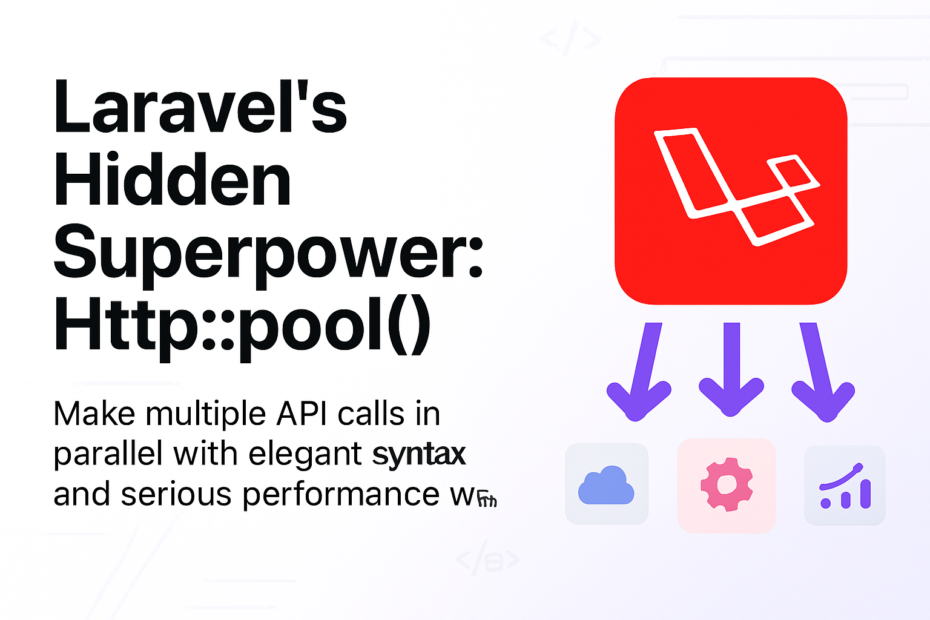If you’re making multiple API calls in Laravel, Http::pool() can cut your response time dramatically. Instead of waiting for each request to finish sequentially, Laravel lets you fire them off in parallel — and return results in a fraction of the time.
Let’s break down how it works, when to use it, and how to handle errors gracefully.
🚀 Why Use Http::pool()?
Imagine you’re fetching data from three external APIs:
$response1 = Http::get('https://api.example.com/users');
$response2 = Http::get('https://api.example.com/posts');
$response3 = Http::get('https://api.example.com/comments');Each request waits for the previous one. If each takes ~1 second, total time = ~3 seconds.
With Http::pool(), Laravel sends all requests simultaneously:
$responses = Http::pool(fn (Illuminate\Http\Client\Pool $pool) => [
$pool->get('https://api.example.com/users'),
$pool->get('https://api.example.com/posts'),
$pool->get('https://api.example.com/comments'),
]);Now, total time ≈ the longest single request — often just ~1 second.
🧪 Real-World Example: Dashboard Aggregation
Let’s say you’re building a dashboard that pulls:
- GitHub repo stats
- Twitter follower count
- Product analytics from an internal API
$responses = Http::pool(fn ($pool) => [
'github' => $pool->get('https://api.github.com/repos/your/repo'),
'twitter' => $pool->get('https://api.twitter.com/user/yourhandle'),
'analytics' => $pool->get('https://internal.api/metrics'),
]);
$githubStars = $responses['github']->json('stargazers_count');
$twitterFollowers = $responses['twitter']->json('followers');
$activeUsers = $responses['analytics']->json('active_users');You get all the data in parallel — perfect for dashboards, reports, or batch jobs.
🛡 Handling Failures Gracefully
Each response is an instance of Illuminate\Http\Client\Response, so you can check for errors:
foreach ($responses as $key => $response) {
if ($response->successful()) {
// process response
} else {
Log::error("API call failed: $key", ['status' => $response->status()]);
}
}You can also use retry() or timeout() inside each call:
Http::pool(fn ($pool) => [
$pool->retry(3, 100)->timeout(5)->get('https://api.example.com/users'),
$pool->retry(3, 100)->timeout(5)->get('https://api.example.com/posts'),
]);📈 Performance Gains
In benchmarks, Http::pool() can reduce total request time by 60–70% when calling multiple APIs. It’s built on top of Guzzle’s async features, but Laravel wraps it in a clean, expressive syntax.
✅ When to Use It
Use Http::pool() when:
- You need to call multiple APIs simultaneously
- Each call is independent (no chaining required)
- You want faster dashboards, reports, or background jobs
Avoid it when:
- Calls depend on each other’s results
- You need strict ordering or transactional logic
🧠 Final Thought
Laravel’s Http::pool() is one of those hidden gems that can supercharge your app’s performance — especially when working with external APIs. It’s elegant, fast, and developer-friendly.
If you’re still calling APIs one-by-one, it’s time to pool up.
References (3)
1Supercharge your Laravel API calls with Http::pool (). https://dev.to/bhaidar/supercharge-your-laravel-api-calls-with-httppool-2cdp
2Advanced Guide to Parallel HTTP Requests in Laravel. https://laravel-hub.com/blog/advanced-guide-to-parallel-http-requests-in-laravel
3HTTP Client – Laravel 12.x – The PHP Framework For Web Artisans. https://laravel.com/docs/12.x/http-client
